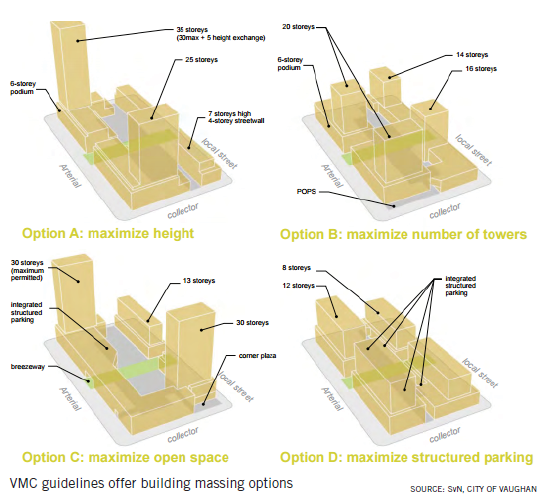
VMC Urban Design Guidelines FLEXIBLE UNDERPINNING
NRU
Dec. 16, 2015
Geordie Gordon
The build out of the Vaughan Metropolitan Centre might not be completed for at least another 40 to 50 years, but the urban design guidelines are now in place. Underpinned by flexibility they are intended to be performance based and to maintain relevance over the long term.
Supplementing the official plan built form policies for the VMC, the guidelines, prepared by SvN, are intended to allow for variations in built form configurations and private sector innovation. Their underlying principles are transit oriented, walkable, accessible, diverse, vibrant, green and beautiful.
SvN principal Drew Sinclair told NRU that the guidelines intentionally stay away from providing prescriptive building typologies, such as podiums with towers or midrise buildings, and instead focus on achieving specific urban conditions, such as the amount of daylight on a street throughout the day.
“Guidelines as prescriptive documents haven’t proven to be particularly effective in delivering really high-quality spaces, because they tend to create a kind of homogeneity that is not necessarily beneficial to cities or communities... [We had] a desire and a real interest in developing a performance-based guideline that could really make clear the intent of the guideline so we could leave some space for innovation on the private side,” he said.
Vaughan urban design and cultural heritage manager Rob Bayley told NRU that the guidelines set out clear expectations for the VMC by building on the secondary plan. However, he also said that the long-term timeframe for the development of the centre presents challenges and creates the need for flexibility.
“The reason why [the guidelines] are principle-based is to allow for the flexibility over time for things to happen over time, because it’s probably going to take 40 or 50 years for this to develop, so there has to be flexibility in these guidelines,” he said. “These guidelines are a working document and will evolve over time, so there may be some opportunities to make changes to this document... as development changes over many, many years.”
Ward 4, Concord/Thornhill North councillor Sandra Yeung Racco told NRU that the guidelines will help to establish a dynamic downtown for Vaughan. She too reinforced the flexibility that underpins the guidelines.
“The direction we have given to staff is that we wanted a guideline that is a living guideline, in that it is able to be adaptable, it’s flexible enough to make changes,” she said.
Sinclair said that one of the aspects that makes the VMC design guidelines notable is the existing site conditions to which they apply. The density of the VMC is low, measured at about 20 people and jobs per hectare in 2006, but will increase substantially in the coming years.
“It’s a unique guideline in that it’s describing something that is fundamentally urban, and relatively high density in an area where there really is no high-density right now... It will be dense. It is happening very fast and you can see that as the subway comes closer to completion,” he said.
As a designated urban growth centre, the VMC is mandated to have a density of 200 people and jobs per hectare. Racco said that that level of density is a good place to start, but it is difficult to predict what could happen to the targets in the future.
“We think this is achievable, we don’t want to go too far and set ourselves too high, and so I’d rather that we set it now, the way it is... I think that we’ve set a realistic goal right now, it could change again,” she said.
The VMC design guidelines were approved by council December 15.
The guidelines are intended to function in combination with other documents that govern the development of the VMC, such as the VMC secondary plan, which sets out the vision for a mixed-use area centred on transit. Other documents include the VMC Streetscape and Open Space Plan, and the VMC Culture and Public Art Framework.

